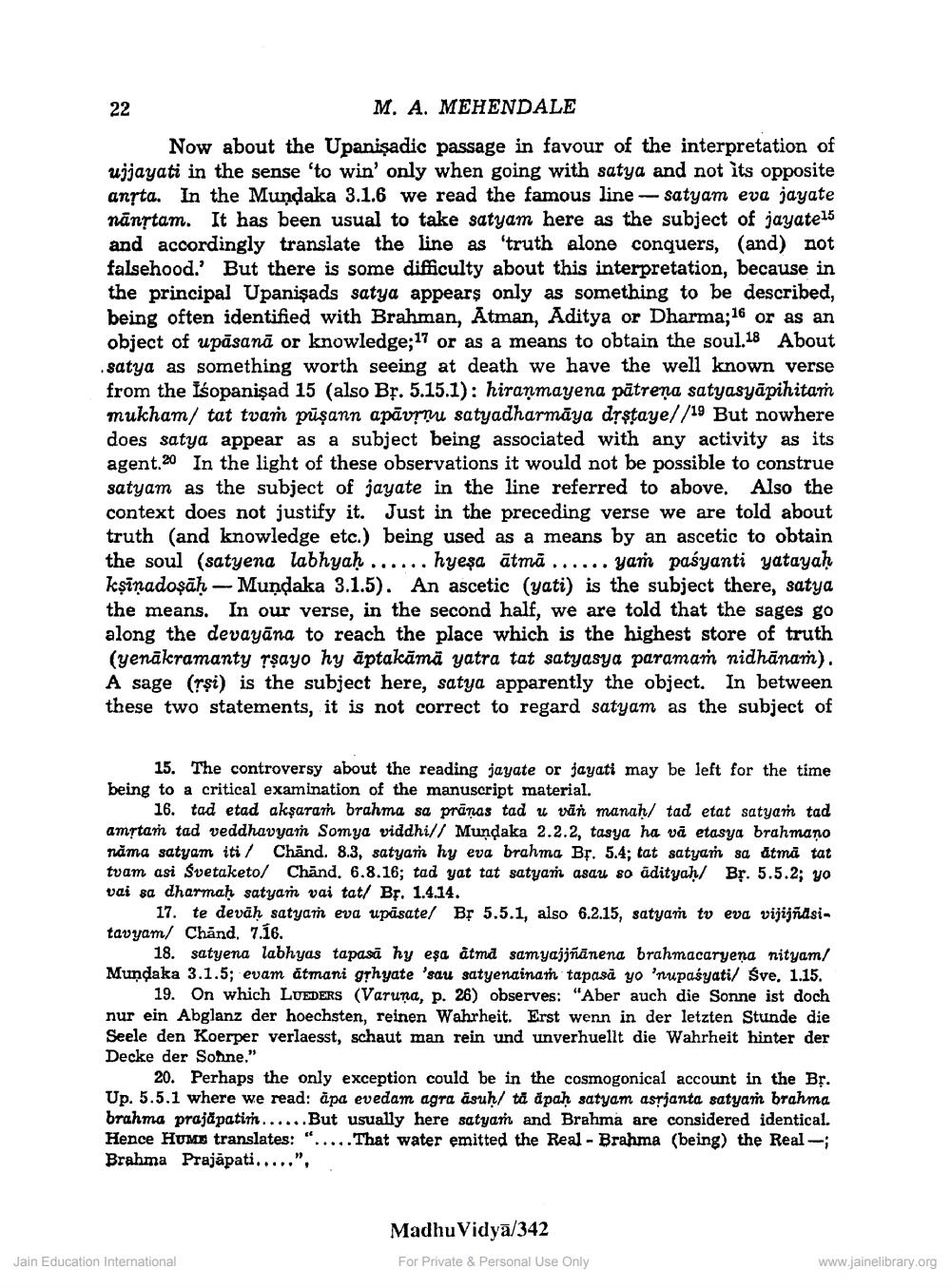________________
M. A. MEHENDALE
Now about the Upanisadic passage in favour of the interpretation of ujjayati in the sense 'to win' only when going with satya and not its opposite anrta. In the Mundaka 3.1.6 we read the famous line-satyam eva jayate nānṛtam. It has been usual to take satyam here as the subject of jayate15 and accordingly translate the line as 'truth alone conquers, (and) not falsehood.' But there is some difficulty about this interpretation, because in the principal Upanisads satya appears only as something to be described, being often identified with Brahman, Atman, Aditya or Dharma; 16 or as an object of upăsand or knowledge; 17 or as a means to obtain the soul.18 About satya as something worth seeing at death we have the well known verse from the Isopanisad 15 (also Br. 5.15.1): hiranmayena pätrena satyasyäpihitam mukham/ tat tvaṁ püṣann apāvṛou satyadharmaya dṛṣṭaye//19 But nowhere does satya appear as a subject being associated with any activity as its agent. 20 In the light of these observations it would not be possible to construe satyam as the subject of jayate in the line referred to above. Also the context does not justify it. Just in the preceding verse we are told about truth (and knowledge etc.) being used as a means by an ascetic to obtain the soul (satyena labhyaḥ...... hyeṣa ātmā...... yaṁ pasyanti yatayaḥ kṣinadoṣāḥ- Mundaka 3.1.5). An ascetic (yati) is the subject there, satya the means. In our verse, in the second half, we are told that the sages go along the devayana to reach the place which is the highest store of truth (yenākramanty rṣayo hy äptakämä yatra tat satyasya paramaṁ nidhanam). A sage (rgi) is the subject here, satya apparently the object. In between these two statements, it is not correct to regard satyam as the subject of
22
15. The controversy about the reading jayate or jayati may be left for the time being to a critical examination of the manuscript material.
16. tad etad akşaram brahma sa prānas tad u van manaḥ/ tad etat satyam tad amṛtam tad veddhavyam Somya viddhi// Mundaka 2.2.2, tasya ha va etasya brahmano năma satyam iti/ Chand. 8.3, satyam hy eva brahma Br. 5.4; tat satyam sa ātmā tat tvam asi Svetaketo/ Chand. 6.8.16; tad yat tat satyam asau so adityah/ Br. 5.5.2; yo vai sa dharmaḥ satyam vai tat/ Br. 1.4.14.
17. te devāḥ satyam eva upasate/ Br 5.5.1, also 6.2.15, satyam tv eva vijijñāsitavyam/ Chand. 7.16.
18. satyena labhyas tapasa hy eșa atma samyajjñānena brahmacaryena nityam/ Mundaka 3.1.5; evam átmani gṛhyate 'sau satyenainam tapasa yo 'nupasyati/ Sve. 1.15. 19. On which LUEDERS (Varuna, p. 26) observes: "Aber auch die Sonne ist doch nur ein Abglanz der hoechsten, reinen Wahrheit. Erst wenn in der letzten Stunde die Seele den Koerper verlaesst, schaut man rein und unverhuellt die Wahrheit hinter der Decke der Sohne."
20. Perhaps the only exception could be in the cosmogonical account in the Br. Up. 5.5.1 where we read: apa evedam agra äsuḥ/ tā apaḥ satyam asṛjanta satyam brahma brahma prajapatim......But usually here satyam and Brahma are considered identical. Hence HUME translates: .....That water emitted the Real - Brahma (being) the Real-;
Brahma Prajapati.....".
Jain Education International
Madhu Vidya/342
For Private & Personal Use Only
www.jainelibrary.org




